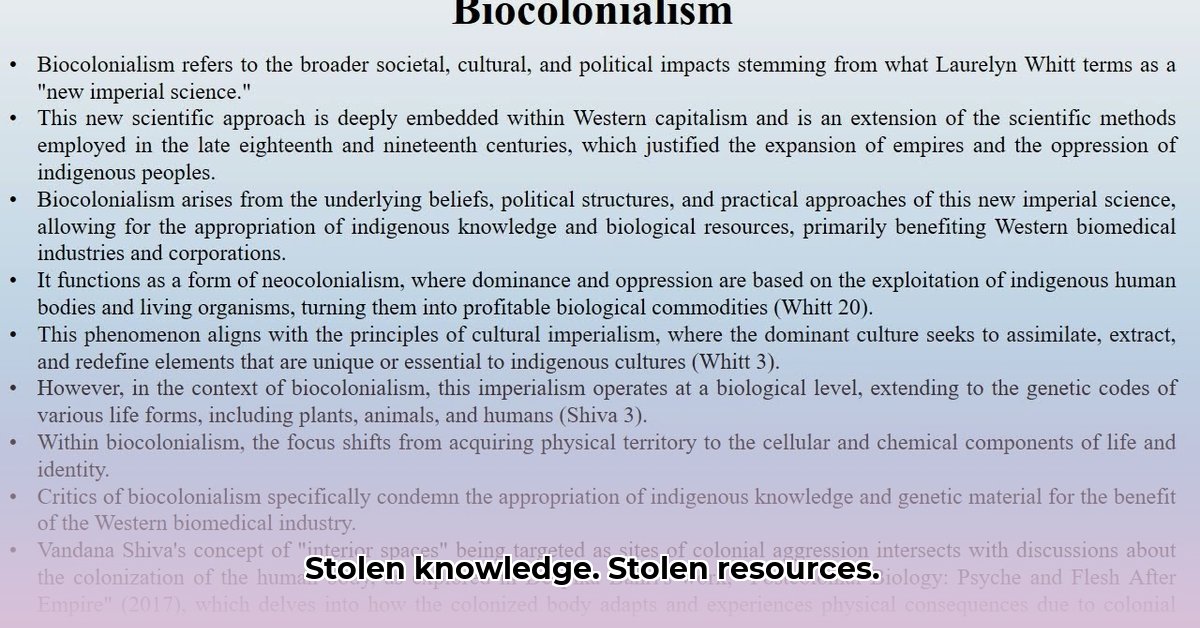Have you ever heard of biocolonialism? It’s essentially the unfair and unethical appropriation of Indigenous peoples’ traditional knowledge and biological resources, such as plants and genetic material, for commercial gain. It’s a contemporary form of colonialism, where the focus shifts from land to the exploitation of natural resources held by Indigenous communities for generations. This article explores the historical context of biocolonialism and its present-day manifestations, highlighting how powerful corporations and researchers have profited at the expense of Indigenous communities. We will also examine existing legal frameworks designed to protect these communities, assess their effectiveness, and propose actionable steps to promote justice and equity. This issue transcends mere resource extraction; it embodies principles of justice, respect, and the preservation of ancestral wisdom.
Understanding Biocolonialism: Unveiling Exploitation
What exactly is biocolonialism? At its core, it represents the unjust and often exploitative acquisition of resources and knowledge from Indigenous peoples, encompassing plants, animals, and genetic material that possess significant value, be it medicinal or economic. This appropriation typically occurs without their informed consent and, more often than not, without equitable distribution of resulting profits. It is a modern manifestation of historical colonial practices characterized by power imbalances. For instance, studies indicate that approximately 70% of the world’s impoverished population identifies as Indigenous [Source: World Bank].
Deep Historical Context: Legacies of Colonialism and Imperialism
The roots of biocolonialism are deeply embedded in the history of colonialism and imperialism, reaching back centuries. A prime example is the case of the Pilocarpus jaborandi plant in Brazil. For generations, Indigenous communities had cultivated this plant for its therapeutic properties. However, Western pharmaceutical companies later acquired the plant, developed medicines from it, and generated substantial profits, while the original custodians of this knowledge received minimal or no compensation. This scenario, repeated across numerous instances, underscores the persistent power dynamics that perpetuate inequality. It prompts fundamental questions regarding resource ownership and equitable benefit-sharing, revealing disparities that demand redress.
Exploitation Defined: The Mechanisms of Biocolonialism
Biocolonialism is a multifaceted system designed to exploit Indigenous resources and knowledge. Key mechanisms include:
- Biopiracy: This involves the direct misappropriation of biological resources and traditional knowledge. Corporations and researchers essentially plunder nature’s assets, often disregarding the rights and interests of the communities who have safeguarded these resources for generations.
- Patenting of Traditional Medicines: This practice entails obtaining exclusive patent rights over medicinal formulations derived from Indigenous knowledge. Companies exploit this knowledge for financial gain, while the originators of these remedies receive no recognition or compensation. It’s akin to appropriating not only the resources but also the cultural heritage associated with them.
- Genetic Material Acquisition: Researchers sometimes collect genetic material from Indigenous populations without obtaining their prior informed consent. This can result in the commercialization of genetic information without any reciprocal benefits for the communities from which it originated. Their unique genetic heritage is treated as a commodity for profit.
- Unethical Research Practices: Research studies conducted in Indigenous communities may, at times, lack proper consultation and respect for cultural practices. Research initiatives should prioritize partnership and collaboration rather than exploitation.
These actions not only deplete resources but also erode cultural heritage and diminish invaluable traditional knowledge, resulting in significant harm. This raises fundamental questions about violations of human rights and the ethical responsibilities of researchers and corporations.
Addressing Injustice: Ethical Dimensions Unveiled
The ethical implications of biocolonialism are profound. It contravenes core ethical principles, including:
- Informed Consent: Indigenous communities are often deprived of full and transparent information regarding the utilization of their resources. They lack the opportunity to provide informed consent based on comprehensive understanding.
- Fair Benefit Sharing: The distribution of profits generated through the exploitation of Indigenous knowledge and resources is frequently inequitable. Indigenous communities often receive a disproportionately small share, or none at all, while others reap substantial financial rewards.
- Cultural Preservation: The exploitation of traditional knowledge jeopardizes cultural heritage and self-determination. It leads to the loss of cultural identity and the severance of spiritual connections to the natural environment.
These ethical considerations underscore the urgent need for stronger international regulations to protect Indigenous communities from exploitation and promote equitable partnerships.
Regulations Analysis: Legal Frameworks and Their Limitations
International agreements, such as the Convention on Biological Diversity (CBD) and the Nagoya Protocol, aim to address biocolonialism [CBD aims to protect biodiversity][1]. These agreements seek to protect biodiversity, promote sustainable resource utilization, and ensure fair and equitable benefit-sharing. However, enforcement of these regulations remains challenging, and biocolonial exploitation persists despite their existence. The central question is whether these agreements are sufficient to effectively curb the ongoing problem. Many experts contend that more comprehensive measures are necessary.
Prominent Examples: Case Studies Examined
Several high-profile cases illustrate the complexities of biocolonialism. The Human Genome Diversity Project (HGDP) ignited discussions about informed consent and the potential for genetic information exploitation. Similarly, the case of Henrietta Lacks’ HeLa cells highlights the ethical dilemmas associated with using human biological materials without proper consent. These instances underscore the pervasiveness and far-reaching implications of biocolonialism.
Practical Solutions: Actionable Steps for a Just Future
Addressing biocolonialism requires a multi-faceted approach involving various stakeholders:
| Stakeholder Group | Short-Term Steps | Long-Term Vision |
|---|---|---|
| Indigenous Communities | Demand transparency, establish community-controlled biobanks, pursue legal recourse when rights are violated, and strengthen traditional governance systems. | Secure robust legal protections and establish equitable benefit-sharing mechanisms that respect Indigenous rights and cultural values. |
| Researchers & Institutions | Adopt rigorous ethical guidelines, engage in genuine collaborative partnerships with Indigenous communities, and prioritize research that benefits Indigenous peoples. | Integrate Indigenous knowledge into research methodologies, promote open access to research findings, and foster reciprocal relationships. |
| Governments & NGOs | Strengthen enforcement of existing regulations, advocate for stricter laws that protect Indigenous rights, and support initiatives that promote community-based resource management. | Foster international cooperation, build capacity in developing nations, and ensure that Indigenous communities have a voice in policymaking. |
| Corporations | Practice ethical sourcing, negotiate fair agreements with Indigenous communities, and respect their rights to free, prior, and informed consent. | Commit to ethical bioprospecting practices, integrate sustainability into corporate policies, and prioritize social responsibility. |
This entails not only creating new rules but also fundamentally reshaping power dynamics and fostering genuine collaboration. The future of biodiversity and Indigenous rights depends on it.
Indigenous Rights: How can indigenous communities effectively leverage international legal frameworks to combat biocolonialism?
Key Takeaways:
- Biocolonialism represents a contemporary form of colonialism that exploits Indigenous knowledge and resources without informed consent or equitable benefit-sharing.
- International legal frameworks like the Convention on Biological Diversity (CBD) and the Nagoya Protocol provide tools to challenge biocolonialism, but enforcement remains a significant challenge.
- Indigenous communities can utilize these frameworks, in conjunction with their own traditional legal systems, to safeguard their rights and resources.
- Success requires building legal capacity, documenting traditional knowledge, and advocating for enhanced international cooperation.
Biocolonialism Defined: A Modern Form of Exploitation
Biocolonialism is not merely a historical relic but a present-day reality. Consider it as a continuation of colonialism focused on the appropriation of biological resources and traditional knowledge. Indigenous communities, who hold invaluable biodiversity and ancestral practices, often witness their heritage being transformed into patents and profits for corporations and researchers, without their consent or equitable compensation. This goes beyond theft; it is a violation of fundamental human rights and self-determination.
Legal Protection: The Power of International Law
Fortunately, certain legal protections exist. The Convention on Biological Diversity (CBD), for example, promotes the conservation of biodiversity and the sustainable utilization of its components. The Nagoya Protocol builds upon this foundation, focusing on access to genetic resources and the fair and equitable sharing of benefits arising from their utilization. These agreements provide a framework to address biopiracy and the unauthorized exploitation of traditional knowledge.
However, the effectiveness of these agreements remains questionable. Enforcing these international laws presents significant challenges. Many countries lack the legal infrastructure or political commitment necessary to protect Indigenous rights effectively. Furthermore, navigating international legal processes can be complex and costly, placing Indigenous communities at a disadvantage.
Protective Measures: How can indigenous communities effectively leverage international legal frameworks to combat biocolonialism?
This question lies at the heart of the struggle against biocolonialism. Effective action requires a multi-pronged, strategic approach:
- Strengthening Legal Capacity: Indigenous communities require access to skilled legal advocates who understand both international law and Indigenous legal traditions. This requires investment in legal training programs and support networks.
- Documenting Traditional Knowledge: Meticulous documentation of traditional knowledge systems and practices is essential. This creates a legal record of ownership and utilization, making it more difficult for others to assert rights over these resources.
- Advocating for Stronger Enforcement: Indigenous communities must actively participate in international forums and advocate for stronger enforcement mechanisms for the CBD and Nagoya Protocol. Applying pressure on governments and international bodies is crucial.
- Integrating Indigenous Legal Systems: Incorporating Indigenous legal traditions and perspectives into national legal frameworks can strengthen the protection of Indigenous rights and resources. This entails a shift towards legal pluralism.
- Strategic Partnerships: Collaboration with NGOs,
- Water Mill Electricity Generator Provides Free Home Power - December 16, 2025
- Water Wheel Electric Generator Provides Free Home Electricity - December 15, 2025
- Choosing the Right Portable Hydro Turbine for Your Needs - December 14, 2025
















